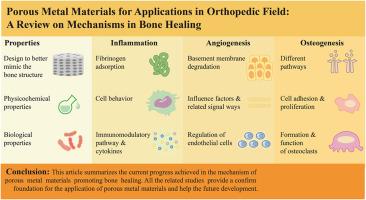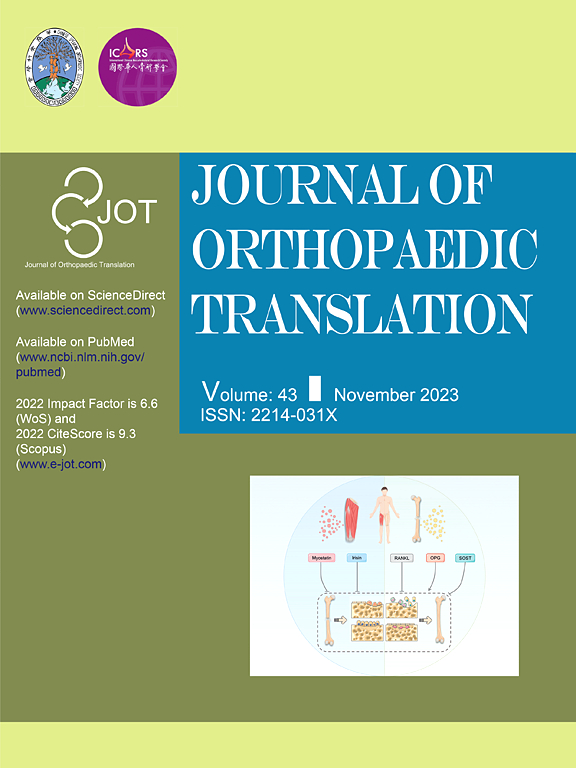Porous metal materials for applications in orthopedic field: A review on mechanisms in bone healing
IF 5.9
1区 医学
Q1 ORTHOPEDICS
引用次数: 0
Abstract
Background
Porous metal materials have been widely studied for applications in orthopedic field, owing to their excellent features and properties in bone healing. Porous metal materials with different compositions, manufacturing methods, and porosities have been developed. Whereas, the systematic mechanisms on how porous metal materials promote bone healing still remain unclear.
Methods
This review is concerned on the porous metal materials from three aspects with accounts of specific mechanisms, inflammatory regulation, angiogenesis and osteogenesis. We place great emphasis on different cells regulated by porous metal materials, including mesenchymal stem cells (MSCs), macrophages, endothelial cells (ECs), etc.
Result
The design of porous metal materials is diversified, with its varying pore sizes, porosity material types, modification methods and coatings help researchers create the most experimentally suitable and clinically effective scaffolds. Related signal pathways presented from different functions showed that porous metal materials could change the behavior of cells and the amount of cytokines, achieving good influence on osteogenesis.
Conclusion
This article summarizes the current progress achieved in the mechanism of porous metal materials promoting bone healing. By modulating the cellular behavior and physiological status of a spectrum of cellular constituents, such as macrophages, osteoblasts, and osteoclasts, porous metal materials are capable of activating different pathways and releasing regulatory factors, thus exerting pivotal influence on improving the bone healing effect.
The translational potential of this article
Porous metal materials play a vital role in the treatment of bone defects. Unfortunately, although an increasing number of studies have been concentrated on the effect of porous metal materials on osteogenesis-related cells, the comprehensive regulation of porous metal materials on the host cell functions during bone regeneration and the related intrinsic mechanisms remain unclear. This review summarizes different design methods for porous metal materials to fabricate the most suitable scaffolds for bone remodeling, and systematically reviews the corresponding mechanisms on inflammation, angiogenesis and osteogenesis of porous metal materials. This review can provide more theoretical framework and innovative optimization for the application of porous metal materials in orthopedics, dentistry, and other areas, thereby advancing their clinical utility and efficacy.

多孔金属材料在骨科领域的应用:骨愈合机制综述
背景多孔金属材料因其在骨愈合方面的优异特性和性能,已被广泛应用于骨科领域。目前已开发出不同成分、制造方法和孔隙率的多孔金属材料。本综述从炎症调节、血管生成和骨生成三个方面阐述了多孔金属材料的具体机制。结果多孔金属材料的设计是多样化的,其不同的孔径大小、孔隙率材料类型、改性方法和涂层有助于研究人员创建最适合实验和临床有效的支架。本文总结了目前多孔金属材料促进骨愈合机理的研究进展。通过调节巨噬细胞、成骨细胞和破骨细胞等一系列细胞成分的细胞行为和生理状态,多孔金属材料能够激活不同的通路并释放调节因子,从而对改善骨愈合效果产生举足轻重的影响。遗憾的是,尽管越来越多的研究集中于多孔金属材料对成骨相关细胞的影响,但多孔金属材料对骨再生过程中宿主细胞功能的综合调控及相关内在机制仍不清楚。本综述总结了多孔金属材料的不同设计方法,以制备最适合骨重塑的支架,并系统综述了多孔金属材料对炎症、血管生成和成骨的相应机制。本综述可为多孔金属材料在骨科、牙科及其他领域的应用提供更多理论框架和创新优化方案,从而提高其临床实用性和疗效。
本文章由计算机程序翻译,如有差异,请以英文原文为准。
求助全文
约1分钟内获得全文
求助全文
来源期刊

Journal of Orthopaedic Translation
Medicine-Orthopedics and Sports Medicine
CiteScore
11.80
自引率
13.60%
发文量
91
审稿时长
29 days
期刊介绍:
The Journal of Orthopaedic Translation (JOT) is the official peer-reviewed, open access journal of the Chinese Speaking Orthopaedic Society (CSOS) and the International Chinese Musculoskeletal Research Society (ICMRS). It is published quarterly, in January, April, July and October, by Elsevier.
 求助内容:
求助内容: 应助结果提醒方式:
应助结果提醒方式:


